Here’s my guide to the 23 most beautiful and important churches in Italy.
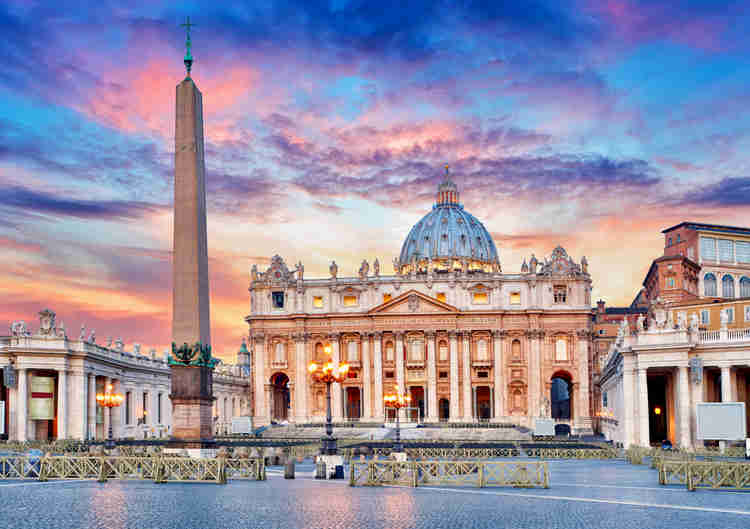
St. Peter’s Basilica in Vatican City
When it comes to art and architecture, Italy is a powerhouse.
Italy is home to some of the world’s most beautiful churches from the Romanesque, Gothic, Renaissance, and Baroque periods. They contain some the most important sculpture and paintings in the Western world.
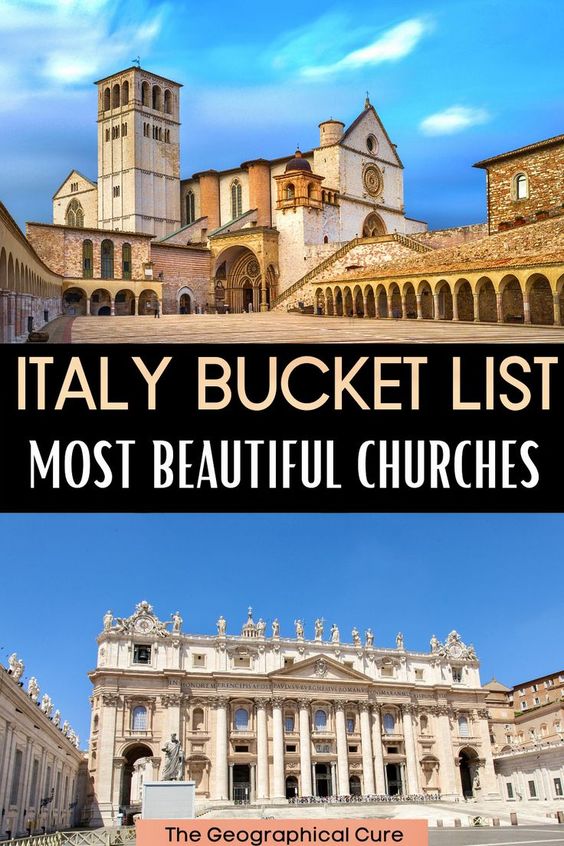
There are a dizzying number of lovely churches in Italy.
It would be impossible to cover them all in a single blog post. These churches are some of Italy’s most famous landmarks.
To give you some Italy destination inspiration, I’ve focused on what I think are the 20 most beautiful churches in Italy, from north to south. Architecture lovers should add these lovelies to their Italy bucket list.
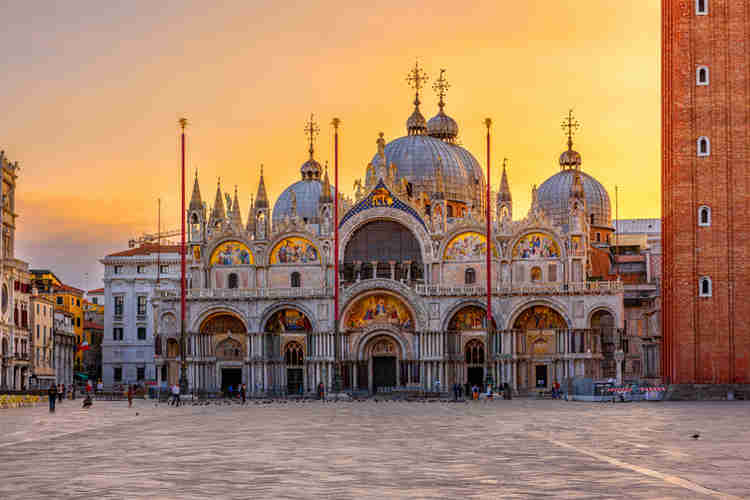
the Basilica of St. Mark’s in Venice
Top 20 Churches In Italy For Your Bucket List
Here are my picks for the most beautiful churches, basilicas, and cathedrals in Italy:
1. St. Marks’ Basilica, Venice
St. Mark’s is an astonishing tour de force of Italo-Byzantine architecture. Consecrated in 1093, it’s one of the world’s most famous churches. Since 1807, St. Mark’s has been the cathedral of Venice.
St. Mark’s was primarily built to house the relics of the evangelist Saint Mark. The church’s footprint is a Greek cross plan, with a giant dome above the crossing point. Each of the four arms is surmounted with a dome. The altar is located at the end of the eastern arm.
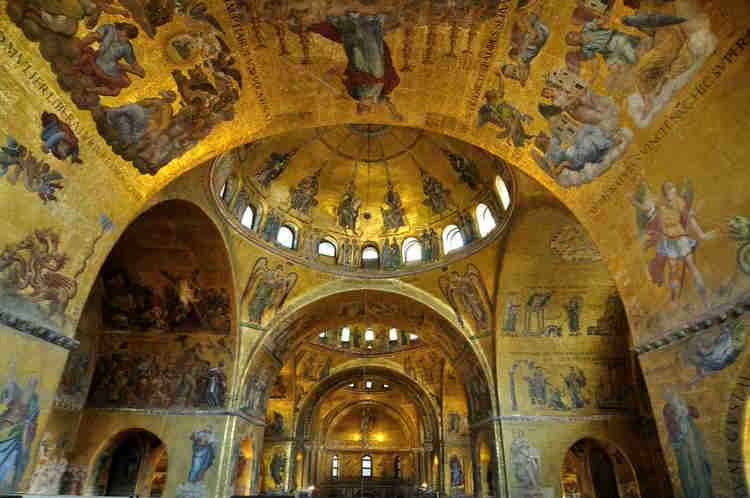
golden mosaics in St. Mark’s Basilica
Inside, is a golden extravaganza of mosaics, 90,000 square feet in total symbolically concentrated high above in the celestial world.
In the middle ages, Venice was the leading school of mosaic in Italy, ahead of Ravenna. The oldest mosaics in St. Mark’s date back to 1070, telling Old Testament stories.
The basilica’s uneven floor is decorated as well. It’s uneven because of high water flooding. There are two pulpits connected by a rare surviving rood screen, separating the clergy and the laity.
The baldachin, or architectural shelter, marks the spot where the body of St. Mark rests in the crypt below.
It’s worth it to cough up the cash for the Pala d’Oro. It’s an elaborate Gothic altar panel on a pivot behind the baldachin.
Also head upstairs to the Loggia dei Cavalli, or Balcony of the Horses. This is where you’ll find the Triumphal Quadriga — the four beautiful bronze horses of St. Mark.
Click here for a skip the line guided tour of St. Mark’s Basilica. This guided tour also gives you roof access.
READ: 2 Day Itinerary for Venice
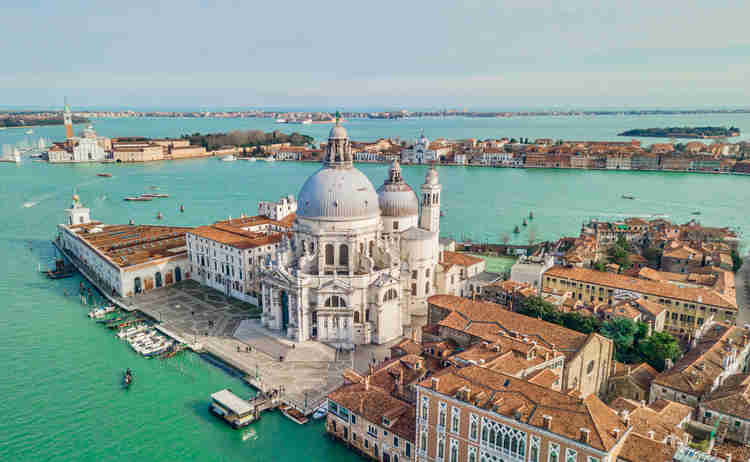
Basilica of Santa Maria della Salute in Venice
2. Basilica of Santa Maria della Salute, Venice
La Salute is a Ventian jewel of Baroque architecture. It was built to symbolize Venice’s return to health after the great Italian plague of 1629-31 that killed 95,000 Venetians.
Built on top of over 1 million timber piles, it was designed by local architect Baldassare Longhena, who also built Ca’ Rezzonico.
La Salute’s most eye catching feature is its crown-like dome, with a statue of Mary on top. The high altar has a famous medieval painting of the Madonna della Salute, the Mediator of All.
The floor is made of beautiful inlaid marble in geometric forms. The Sacristy is almost a mini museum, with paintings by Titian and Tintoretto. The must see work is Tintoretto’s Marriage at Cana.
READ: Must See Sites Along Venice’s Grand Canal
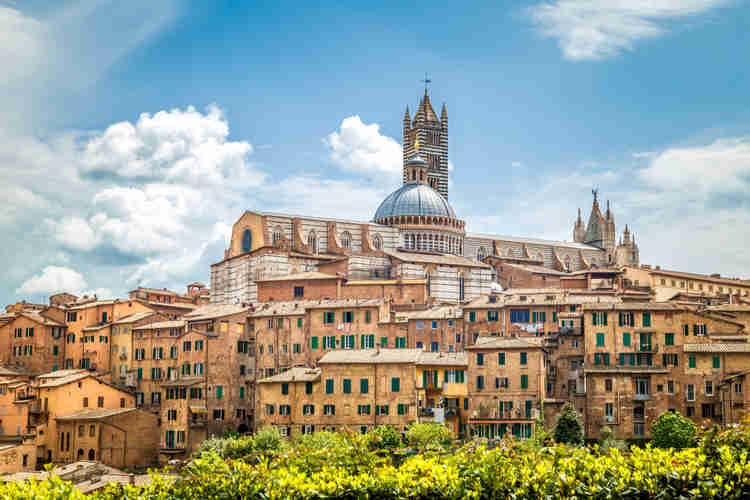
Siena Cathedral
3. Siena Cathedral, Siena
Siena Cathedral is one of Europe’s most beautiful churches, especially for lovers of all things Gothic. It’s the symbol of Siena Italy, clad all over in Siena’s trademark white and dark green marble.
Consistent with the Gothic ethos that “more is always better,” every inch is decorated with marble, mosaics, sculptures, and frescos.
Visiting Siena’s Duomo complex is almost like going to an art museum. It’s filled with mind blowing art from some of the greatest artists of the Gothic and early Renaissance periods — Donatello, Pisano, Pinturicchio, and Michelangelo.
The Duomo complex consists of six must see structures: the cathedral itself, the Piccolomini Library, the Baptistry, the cathedral museum (Museo dell’Opera del Duomo), the Crypt, and the Facciatone viewing terrace.
Here’s my guide to Siena Cathedral, with everything you need to know about the complex — its history, what to see inside, and how to get tickets. And my guide to the Piccolomini Library.
Click here to buy a skip the line ticket to the entire complex. You can also book a guided walking tour of Sienna that includes the cathedral.
READ: One Day in Siena Itinerary
St. Peter’s Basilica
4. St. Peter’s Basilica, Vatican City
St. Peter’s Basilica is the most famous church in Christendom. Designed by Bramante, Raphael, and Michelangelo, it’s a true Renaissance masterpiece. It may be the most ornate space you’ve ever stepped foot in, filled with precious treasures and grandiose decoration.
St. Peter’s Basilica was completed after 120+ years of construction, the reign of 18 different popes, incalculable cost, and the direction of 12 different architects. Measuring more than two football fields in length, it’s by far the largest church in Christendom.
The dome of St. Peters, with input from the revered Michelangelo, is the tallest in the entire world. The basilica is the burial place of Saint Peter and past popes.
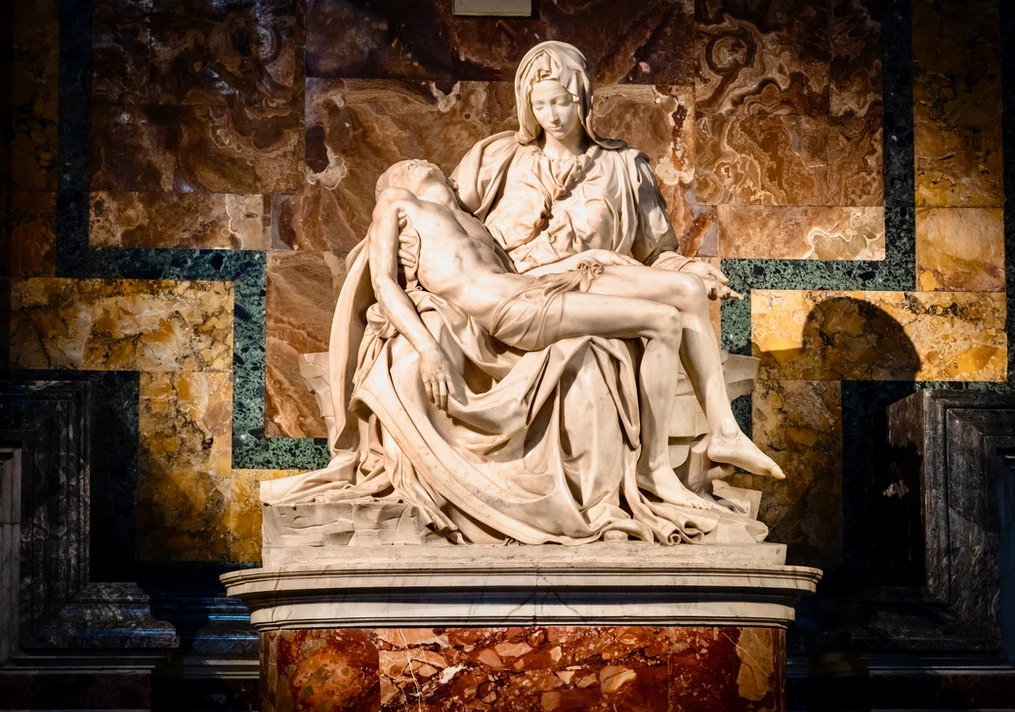
This is where you’ll find Michelangelo’s tragically beautiful Pieta. The church is also chock full of sculptures by Bernini, the greatest sculptor of the Baroque period, including his famous Baldachin that marks the grave of St. Peter.
For just € 6, you can climb up a narrow flight of stairs to inspect the dome at close range. There’s also an elevator for € 8.
From there, you’ll have a bird’s eye view of the nave below. Continue higher to stand on the outside of the dome. This is where you have the iconic view of St. Peter’s Square and a panoramic view of Rome.
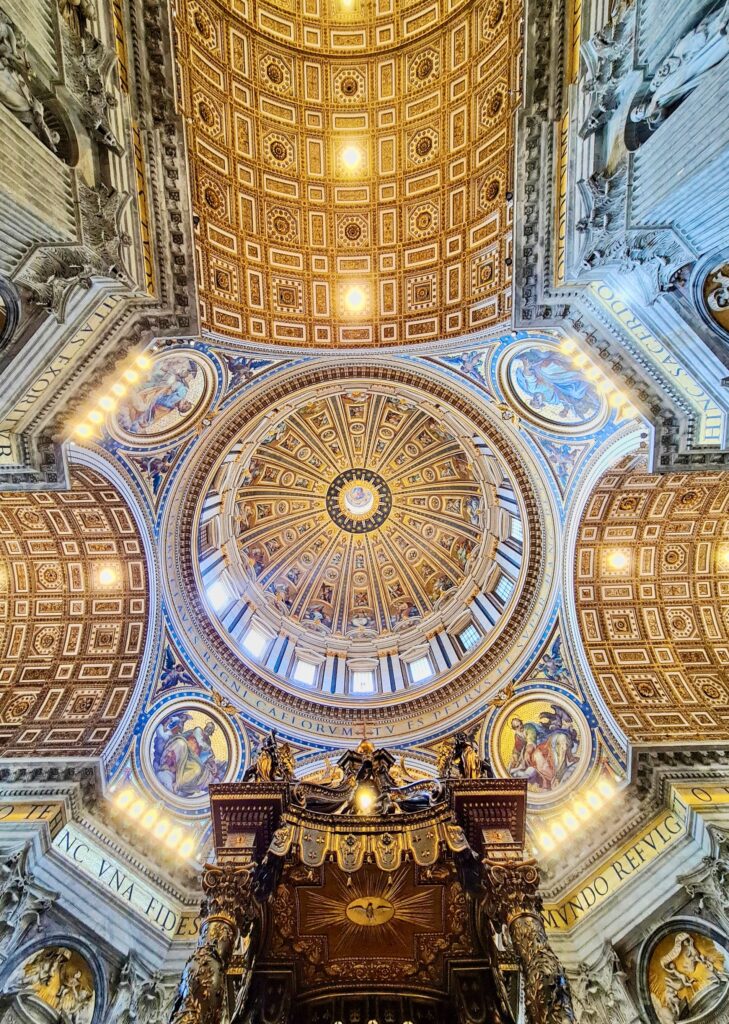
Here’s my complete guide to visiting St. Peter’s Basilica. St. Peter’s is free to enter. If you’re on your own, pick up an audio guide inside. It will take you on an hour long tour.
Click here to book a guided tour of the basilica, which will be helpful because there’s so much to see inside.
If you want to see St. Peter’s tomb in the crypt, you need to sign up for a 1.5 hour tour of the necropolis. Only 250 visitors are allowed per day, so you need to book a crypt tour well in advance.
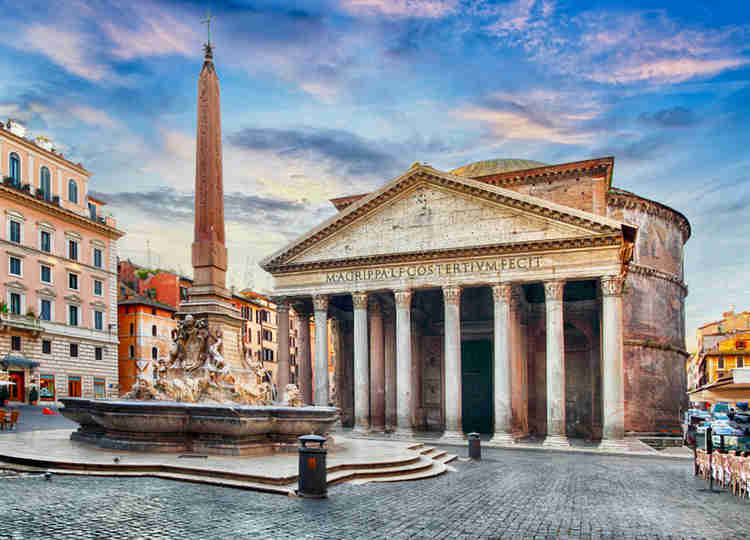
the ancient Pantheon, built by Emperor Hadrian
5. Pantheon, Rome
Without a doubt, the Pantheon is the best preserved building from ancient Rome. The Pantheon was a temple dedicated to all of the gods. It was originally built by Augustus’ right hand man, Marcus Agrippa, in 27 BC. But Agrippa’s version was destroyed by fire.
READ: Guide To Ancient Ruins in Rome
In 120 AD, the Pantheon was rebuilt by Hadrian. The well-traveled emperor, a true Grecophile, reimagined it as an oversized Greek temple.
It has 40 foot tall Corinthian granite columns from Egypt, a pediment, and portico. The church was considered a masterpiece of engineering and mathematical precision.
The Pantheon’s most emblematic feature is its perfect unsupported spherical dome. At the time, it was a major architectural breakthrough.
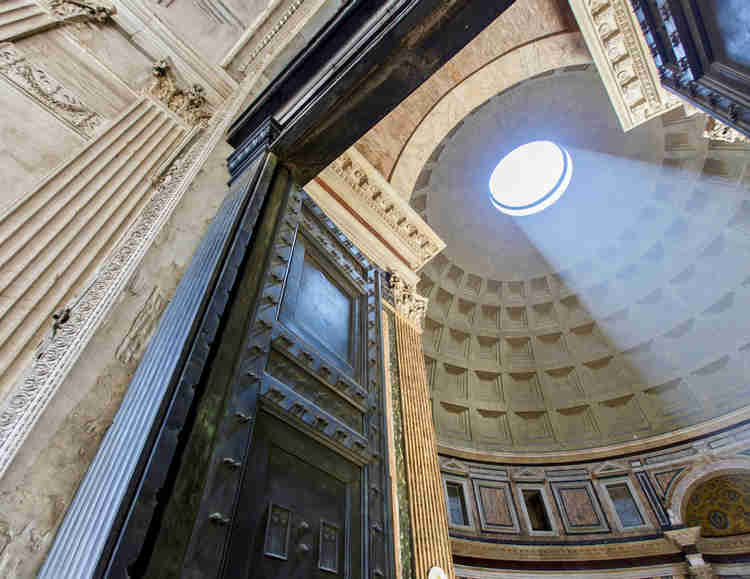
The dome became the model for Michelangelo’s dome for St. Peter’s Basilica and for Brunelleschi’s dome for Florence Cathedral. At the top is the oculus, or eye, which is the Pantheon’s only source of natural light.
After the fall of Rome, the Pantheon became a Christian church, which helped save it from looting at first. But eventually the interior, marble, and gold were all looted in the 7th century, although the marble floor is now lovingly recreated.
The Pantheon is filled with tombs of important Romans, including famed Renaissance artist Raphael.
Here’s my complete guide To the Pantheon. Click here to book a guided tour of the Pantheon.
READ: 5 Day Itinerary for Rome
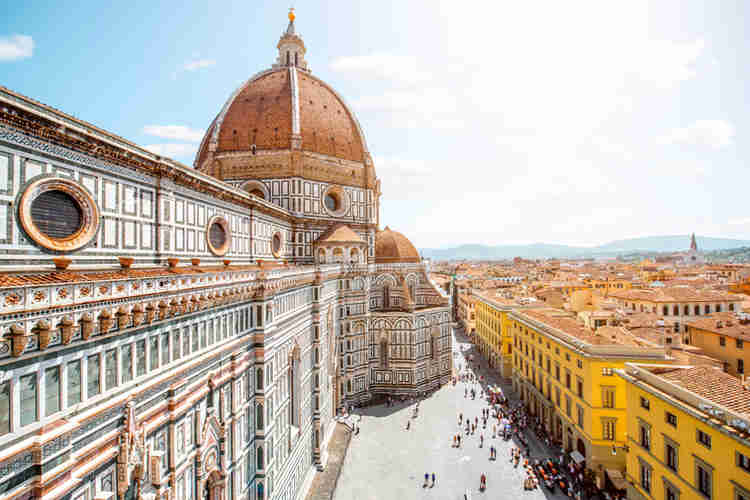
Florence Cathedral
6. Florence Cathedral, Florence
The symbol of Florence is the Cathedral of Santa Maria del Fiore, nicknamed the Duomo. The Piazza del Duomo complex consists the Duomo, the Baptistry, the Giotto Bell Tower, and the stunning Duomo museum. They’re all eminently worth seeing.
Florence’s Duomo is Gothic in style, but not in the light and elegant way you think of Paris’ Notre Dame. It’s made of brown sandstone and beautifully frosted with pink, green, and white marble.
Filippo Brunelleschi’s magnificent terra cotta colored dome, built from 1420-36, is the highlight. The burnt orange Duomo cupola is the very symbol of Florence.
READ: 3 Day Itinerary for Florence
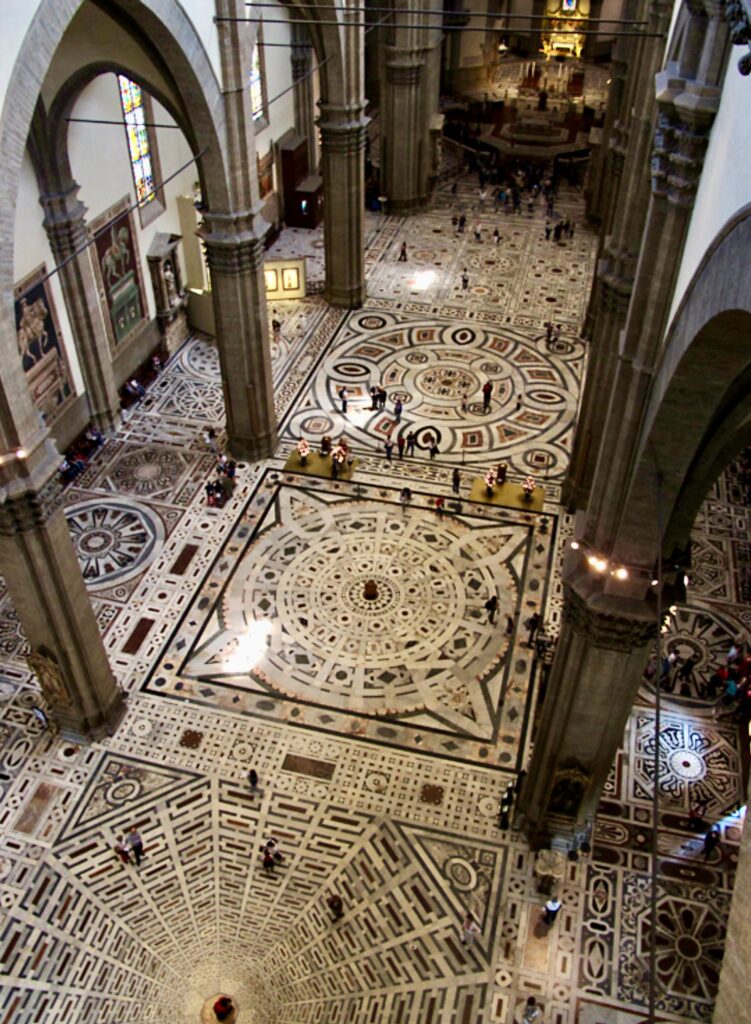
Inside, it’s decorated with high Renaissance frescos by Giorgio Vasari, a Florentine artist and the world’s first art historian.
For panoramic views, climb up Brunelleschi’s dome. You can admire the Vasari frescos up close and have stunning views over Florence. Alternatively, you can take in the superb views from Giotto’s Bell Tower, which might be the best viewpoint in Florence.
Currently, it’s not currently possible to buy one single ticket to access all the areas. Right now, each section of the Duomo complex has a specific ticket.
Click here to book a skip the line ticket and guided tour of the Duomo. Click here to buy a skip-the-line ticket to climb the dome.
Here’s my complete guide to visiting Florence’s Duomo.
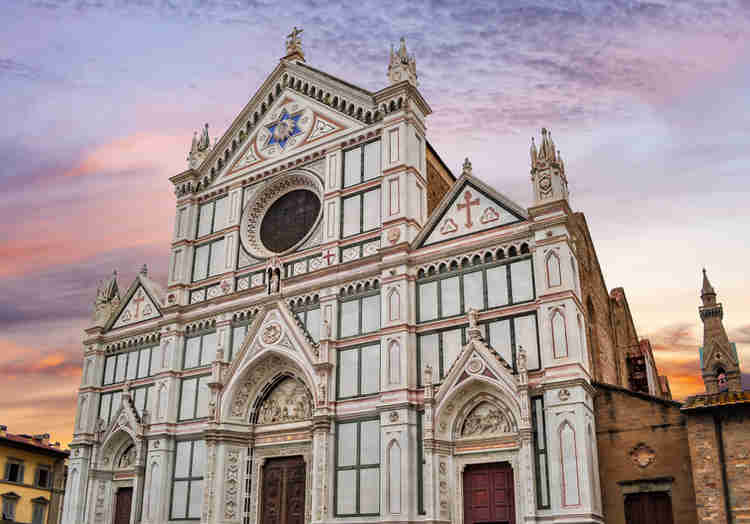
the beautiful Basilica of Santa Croce in Florence
7. Basilica of Santa Croce, Florence
The Basilica of Santa Croce is a must visit site for lovers of Renaissance art. It dates from 1280. The ancient basilica has one of the greatest assemblages of frescos, painting, sculptures, and funeral tombs in the entire world.
The Santa Croce highlights are the frescos by Giotto in the Bardi Chapel and the Peruzzi Chapel. There are also frescos by his students Taddeo and Agnolo Gaddi. The ones by Agnolo are well preserved and have been recently renovated.
Santa Croce is also the resting place of storied Renaissance luminaries. You can find funeral tombs for Michelangelo, Ghiberti, Galileo, Dante, and Machiavelli.
Santa Croce also houses the famous Cimabue Crucifix. The artifact was damaged in a devastating flood in 1966. But it’s been somewhat restored.
Here’s my complete guide to the Basilica of Santa Croce Complex.
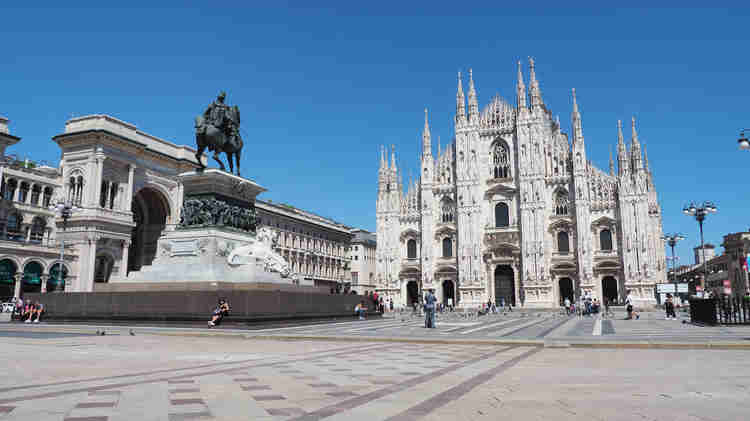
Milan Cathedral in the Piazza del Duomo
8. Milan Cathedral, Milan
The Duomo is the nickname for Milan Cathedral, a world renowned edifice. Built over 600 years beginning in 1368, the Duomo is a flamboyant Gothic masterpiece with 135 marble spires. It’s the fourth largest church in the Europe, second in size in Italy only to St. Peter’s Basilica in Rome.
Begun in 1386, the cathedral was constructed with a white pink marble from the Lake Maggiore region. Cleaned in 2002, the stunning triangular facade was added only in the Napoleonic period.
There’s a golden Madonna statue on the tip top. By law since 1930, no building can be taller than the symbol of Milan.
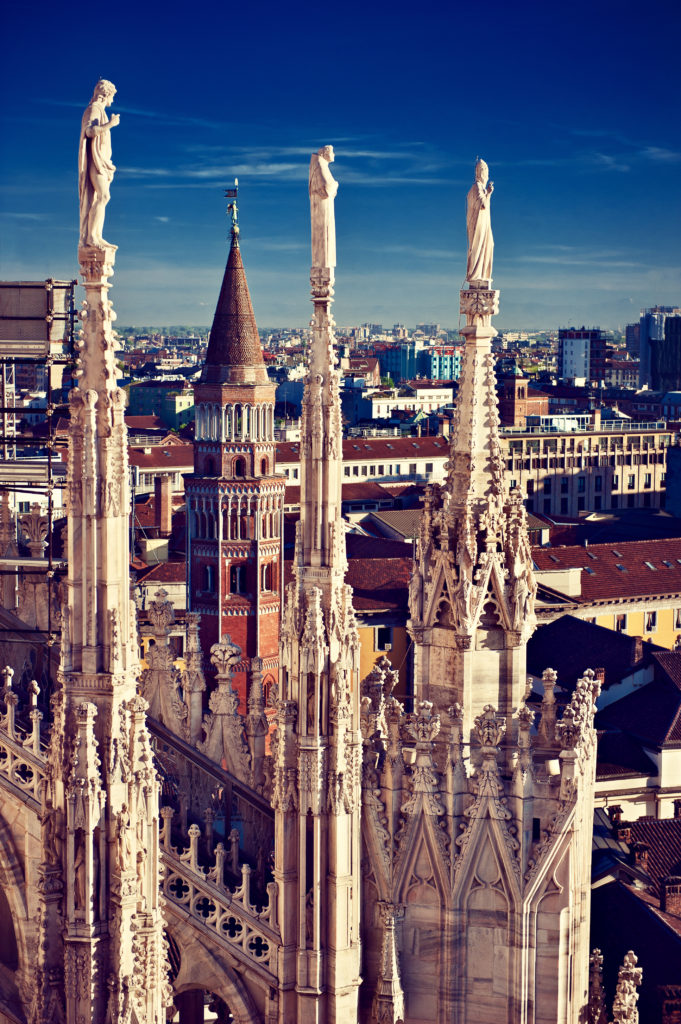
Five portals beckon you inside. The Duomo interior seems cavernous. There’s plenty to admire — ornate statues, paintings, and the sarcophagi of famous Milanese citizens. In the transept, you’ll find the rather ghoulish statue of St. Bartholomew Skinned by Marco d’Agrate, a Leonardo student.
The Duomo’s truly spectacular and unmissable feature is its rooftop terrace. It can be reached either via a staircase or elevator.
From the rooftop, you have an excellent view of the details of the intricate stonemasonry, especially the fanciful gargoyles that serve as drains. You can see the panorama of the entire city before you. It’s especially nice at sunset.
Click here to buy a skip the line Duomo ticket with access to the rooftop terrace, which I definitely advise getting. Click here for a guided tour with rooftop access.
READ: Must See Sites in Milan
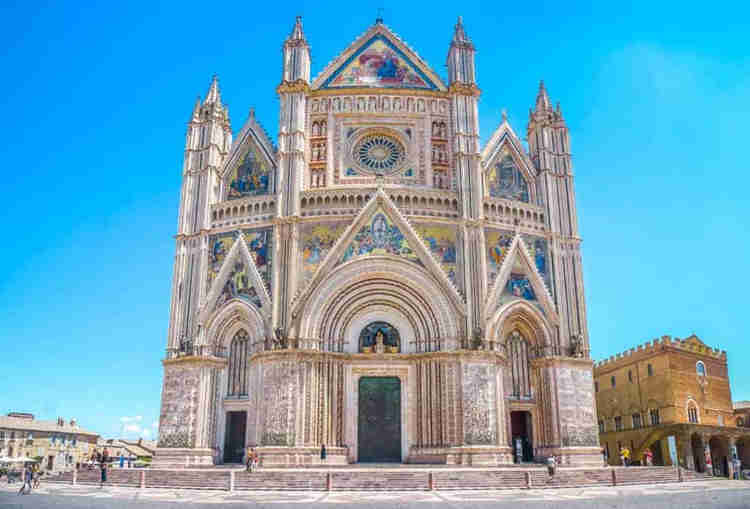
Orvieto Cathedral
9. Orvieto Catheral, Orvieto
Medieval Orvieto is a popular day trip from Rome. The hilltop town’s piece de resistance is its magnificent cathedral, a marvel of theatricality. Orvieto Cathedral is one of the most beautiful and ancient churches in Italy.
Begun in 1290, Orvieto Cathedral is a riveting ensemble of spires, spikes, golden mosaics, statuary, stained glass, and black and white striped marble. And that’s just the facade.
Inside, the Chapel of San Brizio boasts one of the Renaissance’s greatest fresco cycles by Luca Signorelli. The frescos depict the usual religious themes — temptation, damnation, and salvation.
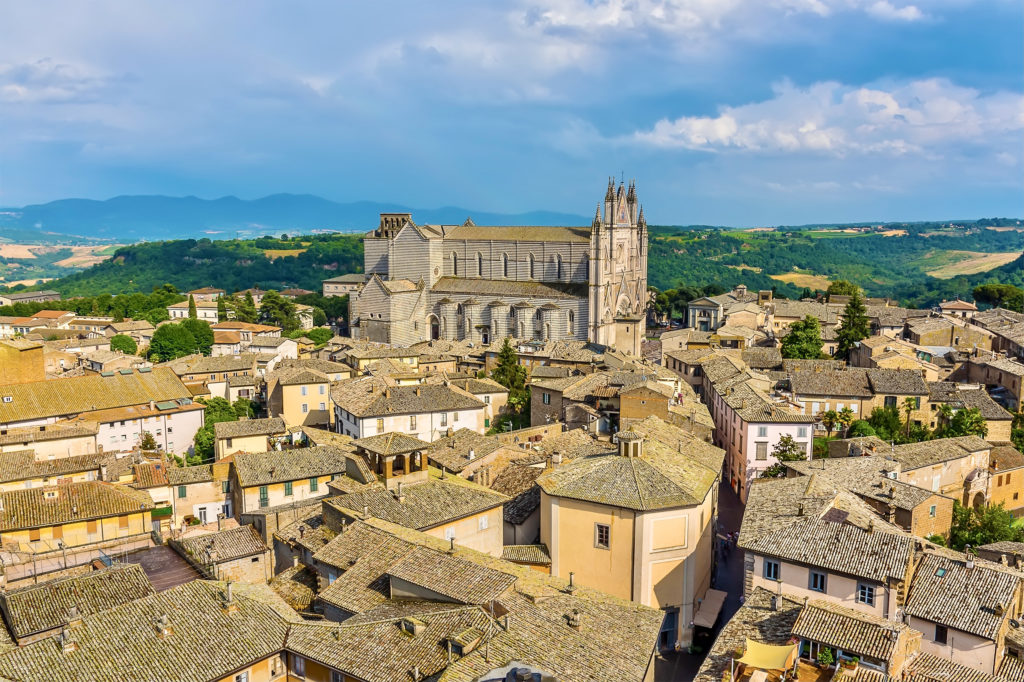
But they’re a searing vision of the end of the world, executed with fiendish exuberance. Michelangelo came to inspect the chapel before beginning his own master work, the Sistine Chapel.
In the cathedral museum around the corner, you can inspect 2,000 works of art preserved from the church. The best works are by Andrea Pisano and Francesco Mocchi.
Here’s my guide to Orvieto Cathedral. Click here for a 2 hour guided tour of the cathedral and its underground.
READ: One Day In Orvieto Itinerary
the Basilica of St. Francis of Assisi
10. Basilica of San Francesco, Assisi
Located in Umbria on the slopes of Mount Subasio, Assisi was the home of the revered Saint Francis, a medieval monk and mystic.
The basilica is dedicated to Italy’s most famous penitent saint. And it holds one of Italy’s greatest relic — the body of Saint Francis.
There are two parts to the church — the lower church (for pilgrims) and the upper church (for clergy).
You’ll want to see the lower church, the tomb of Saint Francis, the cloister, and the upper church. The basilica was declared a UNESCO site in 2000.
In the 14th century, the greatest artists of the Early Renaissance converged on the basilica to decorate it — Simone Martini, Pietro Lorenzetti, Cimabue, Pietro Cavallini, and (possibly) Giotto.
They created a radical new style of Italian art, replacing Byzantine stylization with naturalism. The seeds of the High Renaissance in Assisi would blossom decades later in Florence.
Here’s my complete guide to visiting the Basilica of St. Francis in Assisi. Click here for a 3 hour walking tour of the town of Assisi and the basilica.
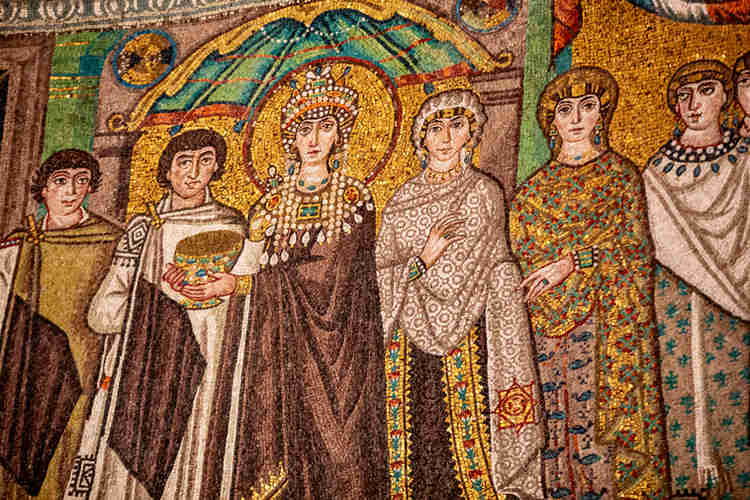
mosaic of Theodora
11. Basilica of San Vitale, Ravenna
Finished in 547 and almost 1500 years old, the Basilica of San Vitale is Ravenna’s masterpiece. It boasts dazzling Byzantine mosaics in the presbytery and choir, meant to evoke a heavenly realm.
In the apse above the altar, there’s a mosaic depicting Christ the Redeemer. He’s sitting on an orb representing the universe. Below him flow the four rivers of paradise. On either side is an angel. Jesus hands a crown to San Vitale and a bishop holds a model of the church.
Just below is Ravenna’s pièce de résistance — two famous panels dedicated to the Emperor Justinian and his wife Theodora. They show the pair making offerings to Jesus against a field of gold.
They are both resplendent in fine capes and jewels, proving to the world that they’re back in charge. In reality, the mosaic is a piece of political propaganda.
Here’s my complete guide to seeing the mosaics of Ravenna. Click here for a tour of San Vitale and the mosaics of Ravenna.
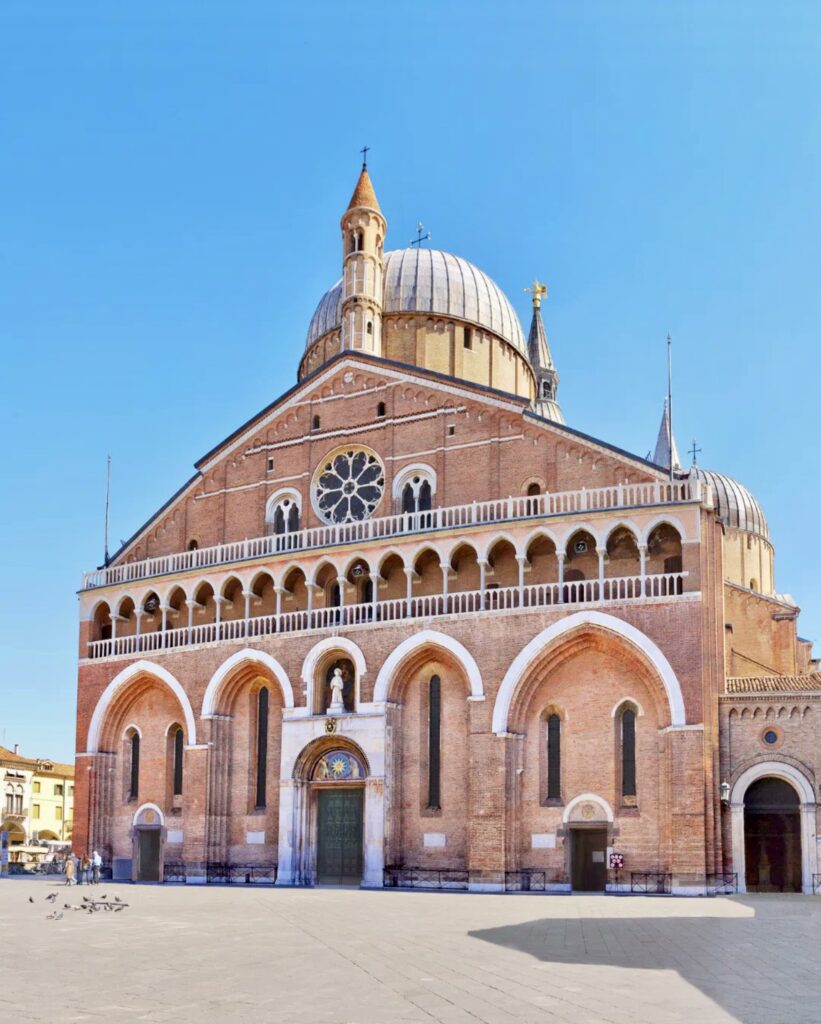
12. Basilica of St. Anthony, Padua
Built in 1310, St. Anthony is a spectacular 8 domed basilica. It combines Byzantine, Romanesque, and Gothic styles. There are a pair of minaret-like bell towers.
Inside, the basilica is richly decorated. It has a checkerboard marble floor and its walls are covered with Renaissance reliefs. The basilica houses the remains of Saint Anthony (or art least his tongue and vocal cords) and other tombs.
The basilica’s chief treasure is the main altar. There you’ll find 8 bronze sculptures by the great early Renaissance artist, Donatello. They illustrate the miracles of St. Anthony.
In front of the cathedral is the famous equestrian statue by Donatello, Gattamelata. It was the first equestrian statue carved since Roman antiquity, presaging a revival of equestrian monuments in the Renaissance.
Click here for a guided tour of St. Anthony. You can also check out my one day in Padua itinerary for more ideas of things to see in the city.
READ: Guide To the Scrovegni Chapel in Padua
St. Andrew’s Cathedral in Amalfi
13. St. Andrew’s Cathedral, Amalfi
The Cathedral of St. Andrew was built in the early 1200s. The cathedral boasts a dramatic location atop a steep flight of stairs. It has a Moorish-influenced exterior, with a riot of stripes and mosaics.
Inside, you’ll find a sumptuous Baroque interior. Pilgrims come for the relics of St. Andrew the Apostle, the patron saint of Amalfi, in its crypt.
Connected to the cathedral is an older basilica (now a small museum) and the fascinating Cloister of Paradise. Both contain medieval murals.
The cloister houses the tombs of wealthy Amalfi citizens. There’s a lovely courtyard surrounded by arcaded porticos of white marble.
For more information, here’s my complete guide to Amalfi Cathedral.
READ: One Week In Amalfi Coast Itinerary
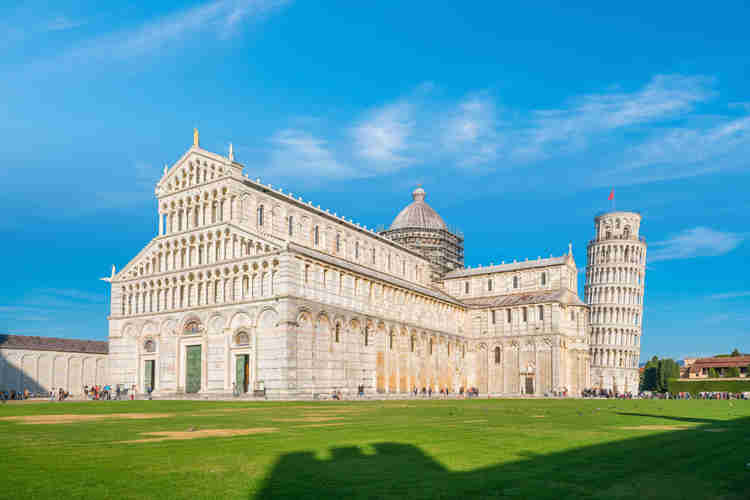
Pisa Cathedral on the Field of Miracles
14. Pisa Cathedral, Pisa
Pisa’s exuberant Duomo is a wonderful example of Pisan Romanesque architecture. Like most duomos, it’s dedicated to St. Mary of the Assumption. Pisa’s Duomo is the most ancient cathedral in Italy, older than the cathedrals in Siena and Florence.
Construction of this doughty edifice began in 1063. The Duomo’s facade is decorated with alternating black and white marble stripes, quarried from Carrara.
Inside, there’s a Latin cross plan with an unusual 5 aisles plan — a spacious central nave and two flanking aisles on each side. The granite Corinthian columns and arches dividing the aisles are ancient Roman.
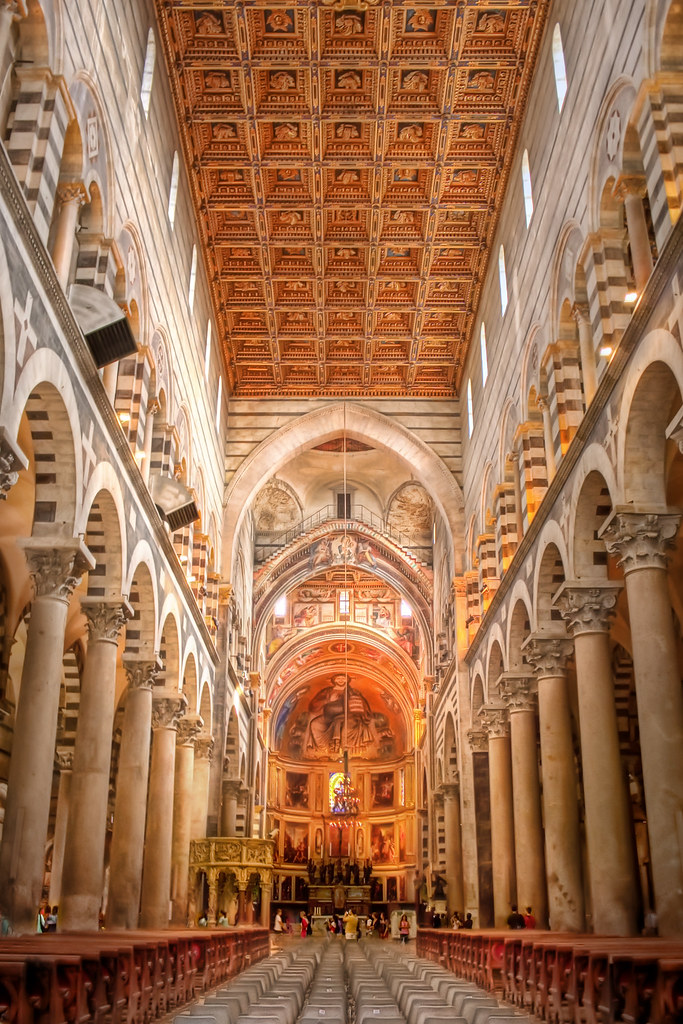
You’ll find Roman inscriptions in the spoglia, or spoils, that Pisans brought back from conquests and incorporated into the Duomo architecture.
In the conch of the apse, you’ll find mosaics attributed (perhaps erroneously) to the great late 13th century painter, Cimabue. By far the most important piece inside the Duomo is the elaborate Gothic pulpit carved by Giovani Pisano in the early 14th century.
Here’s my complete guide to the must see attractions in Pisa. Click here for a must have entrance ticket the Duomo and Leaning Tower. Click here for an all inclusive ticket to the Field of Miracles.
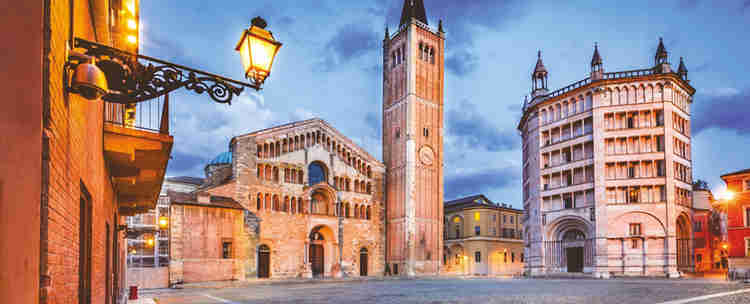
Parma Cathedral and Baptistery
15. Parma Cathedral, Parma
Parma’s pretty cathedral lies in the Duomo Square, next to the pink Baptistery. The ancient cathedral, dedicated to the Virgin Mary, is considered one of the finest examples of Romanesque architecture in Italy.
Parma Cathedral was originally erected by the heretic bishop Cadalus. It was destroyed by an earthquake in 1117, and rebuilt in the 12th century. The 13th century bell tower is topped by a gilt copper angel.
The facade features three loggia floors and three portals. The doors were sculpted by Luchino Bianchino in 1494. Inside, the Cathedral has a Latin cross plan.
The ceiling and walls are frescoed in the Mannerist style. The frescos were recently restored and are an amazing sight. A 16th century red marble staircase leads up to the transepts. There, you’ll find the famous relief of the Deposition by Benedetto Antelami.
You can also find beautiful Correggio frescos in the cupola, dating from 1526. The fresco depicts the Virgin Mary ascending through a sea of limbs, faces, and swirling drapery. Using a radical and illusionistic foreshortening techniques, Correggio’s figures in the clouds protrude in a wild delirium.
READ: One Day In Parma Itinerary
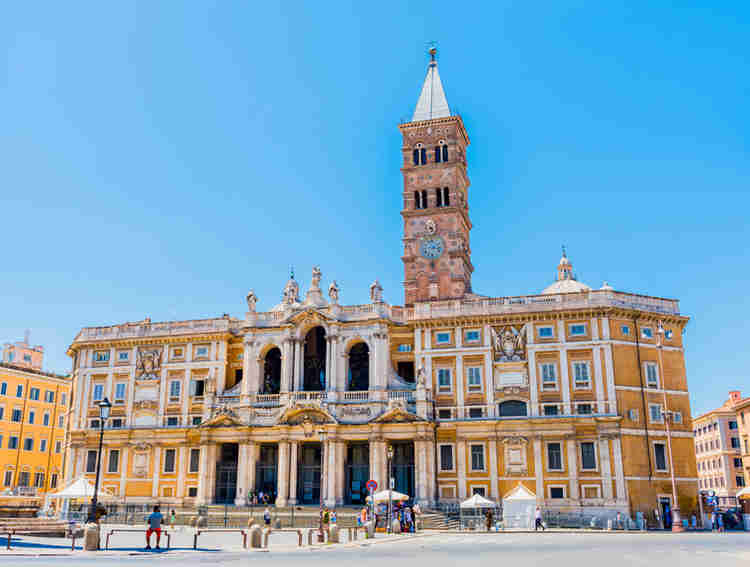
Basilica of Santa Maria Maggiore in Rome
16. Basilica of Santa Maria Maggiore, Rome
Sant Maria Maggiore sone of the most beautiful churches in Italy. The basilica is a UNESCO-listed site in Rome’s Monti area, dating to the 5th century.
It’s one of four papal basilicas in Rome and retains its original shape (with some embellishments). The basilica was the scene of a miraculous snowfall in the middle of August in the 4th century, which is celebrated annually in a digitized show.
The basilica’s claim to fame is a perfectly preserved Byzantine interior. 5th century mosaics decorate both sides of the nave. 13th century mosaics are in the apse.
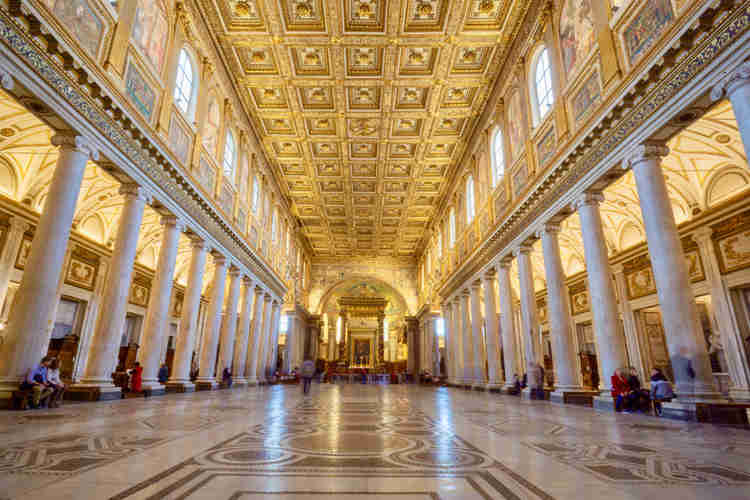
The basilica also has a stunning coffered ceiling, sculpted by Giuliano Sangallo in 1450. It’s covered in gold, brought back by Columbus. And there’s a famed nativity scene by Florentine artist and architect Arnolfo di Cambio.
Bernini fans can pay homage to him here, as his tomb is in the church. If you take a guided tour, you’ll get to see a secret spiral staircase designed by Bernini himself.
It’s in a residential apartment attached to the basilica. The staircase is an architectural curiosity because there’s no central supporting rail.
Here’s my guide to Santa Maria Maggiore. Click here for a guided tour of the beautiful basilica.
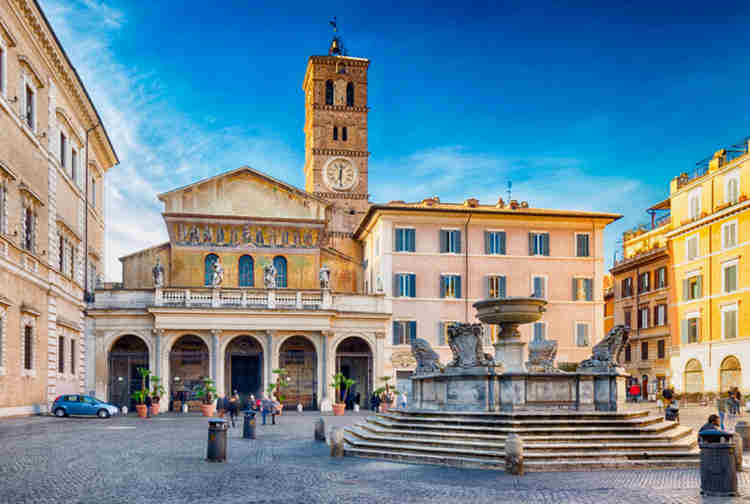
Basilica of Santa Maria in Trastevere in Rome
17. Basilica of Santa Maria in Trastevere, Rome
Santa Maria in Trastevere is one of Rome’s oldest churches, built circa 350 AD. It was Rome’s first church dedicated to the Virgin Mary.
In the 12th century, Pope Innocent II, a native of Trastevere, rebuilt the church. Like Santa Maria Maggiore, it boasts impressive mosaics from the 12th and 13th centuries.
Two rows of 22 large columns lead up to the nave. The apse in the main altar is covered in gilded Byzantine style mosaics.
Be sure to look for the 6 panels known as The Life of the Virgin. There’s also a 13th century mosaic floor with elaborate interlacing patterns.
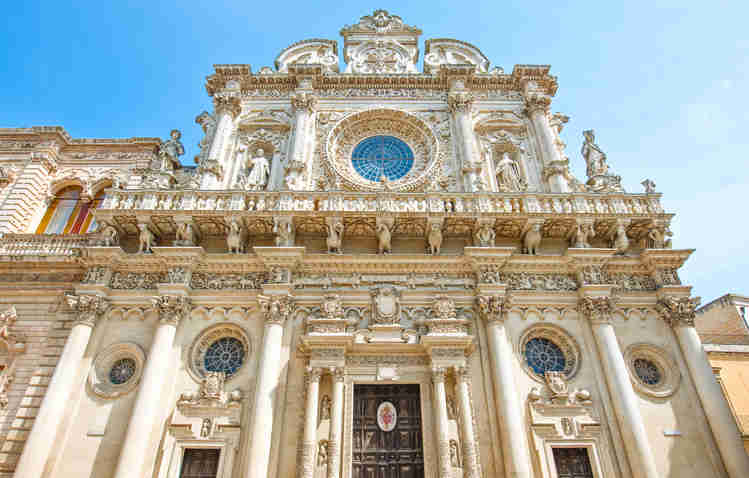
the gaudy facade of Lecce’s Basilica of Santa Croce
18. Basilica of Santa Croce, Lecce
Your first glimpse of Lecce’s Basilica of Santa Croce will take your breath away. The church is a gleaming riot of sculptural decoration that resembles a wedding cake. The church is the symbol of Lecce’s Baroque splendor.
Building began in 1549. 100 years later, the church was completed.
The finest craftsmen in Puglia worked on the church. They left incredibly delicate and detailed carvings on nearly every inch of the facade. A swirl of sheep, cherubs and beasties create a magnificent allegorical feast.
Inside, the church is airy and richly decorated. It’s built on a Latin cross plan. There are beautiful depictions of the Adoration of the Shepherds, the Annunciation, the Visit of Mary to St. Elizabeth, and the Flight to Egypt.
There are 16 altars and side chapels. The chapel in the left transept is considered the greatest masterpiece of Baroque in the south.
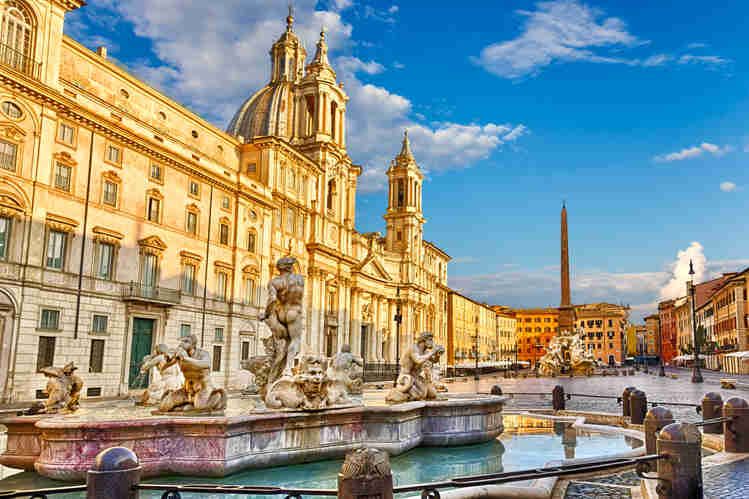
Church of Saint Agnes in Rome’s Piazza Navona
19. Church of Saint Agnes, Rome
The Church of Saint Agnes was built by Borromini, an Italian architect who helped launch Roman Baroque architecture. Borromini’s works combine classicism with passion. He used concave and convex forms to animate his buildings and eschewed over-decoration.
Sant’Agnese Church in the Piazza Navona is one of his best works. Everyone goes to Piazza Navona and admires the striking concave facade. Most people don’t step inside the church. Do it, it’s free!
The Baroque church of Sant’Agnese was commissioned by Pope Innocent X, of the Doria Pamphilj family. It stands on the site of a much older church dedicated to St. Agnes. According to popular belief, she was martyred on this very spot.
The key element is the concave facade, a design of Borromini’s that revolutionized Baroque architecture. It’s an ingenuous device, which accommodates a small space and allows the church to be seen from anywhere in Piazza Navona. The facade is made of white travertine limestone with three portals.
Pink and white marble covers the walls inside. The bright and simple interior is filled with Baroque statues. Beautiful frescos decorate the dome.
Here’s my complete guide to Rome’s Sant’Agnese Church.
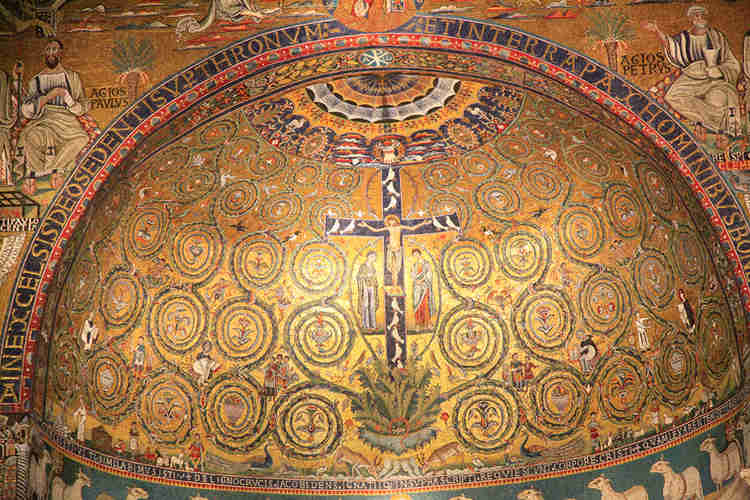
mosaics in Rome’s Basilica of San Clemente
20. Basilica of San Clemente, Rome
The Basilica di San Clemente is an 11th century church, built atop a 4th century church. It’s located in Monti, just a short walk from the Colosseum. Inside, you’ll see beautifully frescoed ceilings and original gold mosaics in the apse.
But the real treasures lie beneath the inlaid marble floors. San Clemente is one of Rome’s best underground archaeological sites.
Underground, you’ll find layers of Christian history. There are early Christian wall paintings, a 3rd century pagan temple, a 1st century residence, a secret Mithraic worship site, and the Cloaca Maxima (the sewer system of ancient Rome).
Click here to book an underground tour of San Clemente. It’s one of the most unusual things to do in Rome.
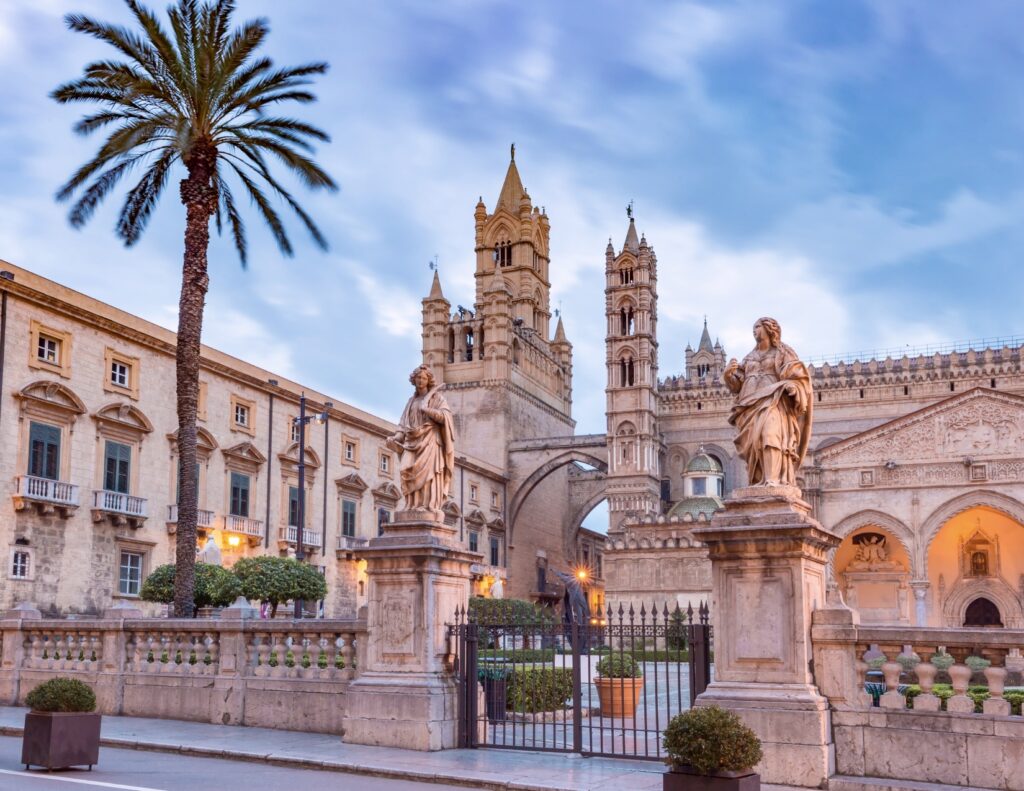
21. Palermo Cathedral, Palermo Sicily
Founded in 592, Palermo Cathedral is a mixture of architectural styleswith Greek, Roman, Arab, Norman, and Swabian features. It was intended to surpass the beauty of Monreale Cathedral.
The cathedral was a mosque when the city was ruled by the Arabs and reconverted into a Christian building when the Normans settled in. It’s connected, through two pointed arches to the Archbishop’s palace, making the church look a bit like a castle.
A large square in front is filled with statuary. You enter through the south portal, which is magnificent. It has fine wooden doors and three ornate pointed archways.
The interior isn’t as grand the churches I mentioned above. It’s mostly Neo-Classical in design (meh) and a huge contrast to the extravagant exterior.
But you can visit two chapels in the right aisle that host six tombs of the kings of Palermo. The most important are those of Frederick II and Roger II. You’ll also find a loaded-with-silver chapel dedicated to Rosalia, Palermo’s patron saint.
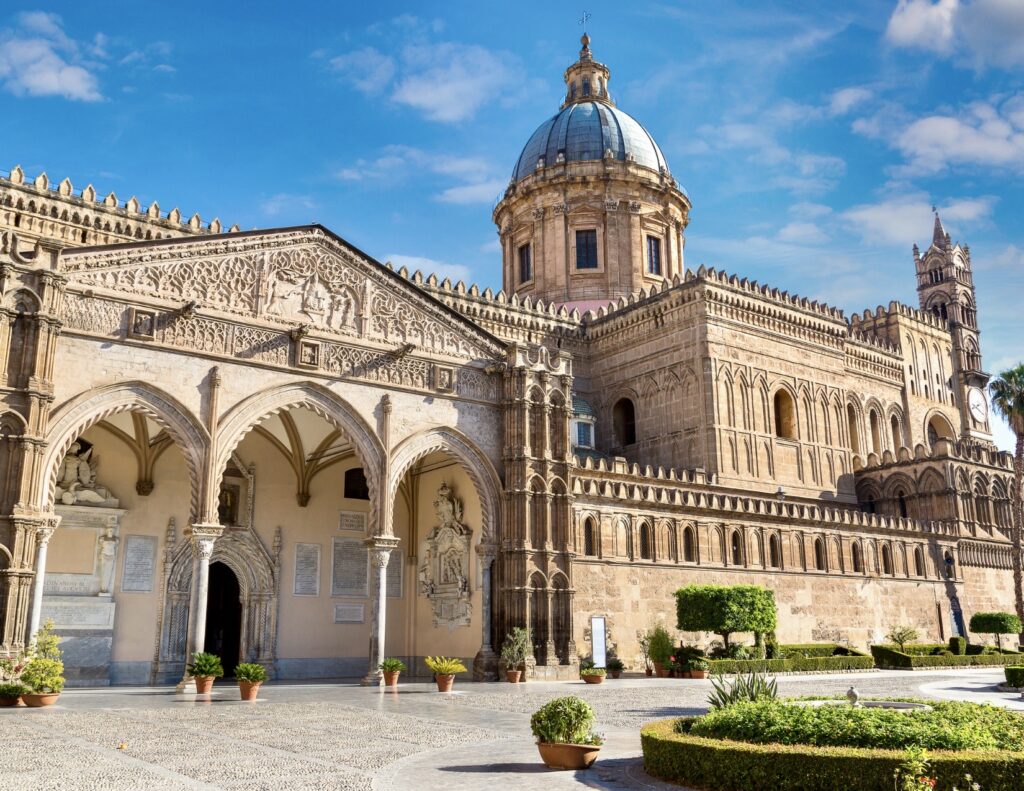
The best part is hiking up to the cathedral rooftop. You’ll have 360 views of Palermo. It’s not for the faint of heart or those scared of heights. You climb a spiral staircase that’s dimly lit and walk along a narrow path.
Entry to the cathedral nave itself is free. There are several variations of tickets.
For 15 euros, you can see everything including the tombs, treasury, crypts, rooftop terrace, and the Diocesan Museum. The Diocesan Museum is across the street in the Archbishop’s Palace. It’s fairly unremarkable, though, with anonymous religious paintings.
Here’s my guide to Palermo Cathedral. Click here to book a skip the line ticket for the cathedral. You can also visit the cathedral on a guided art and architecture tour.
Be sure to wear something appropriate. Women cannot wear shorts, miniskirts, or sleeveless tops inside.
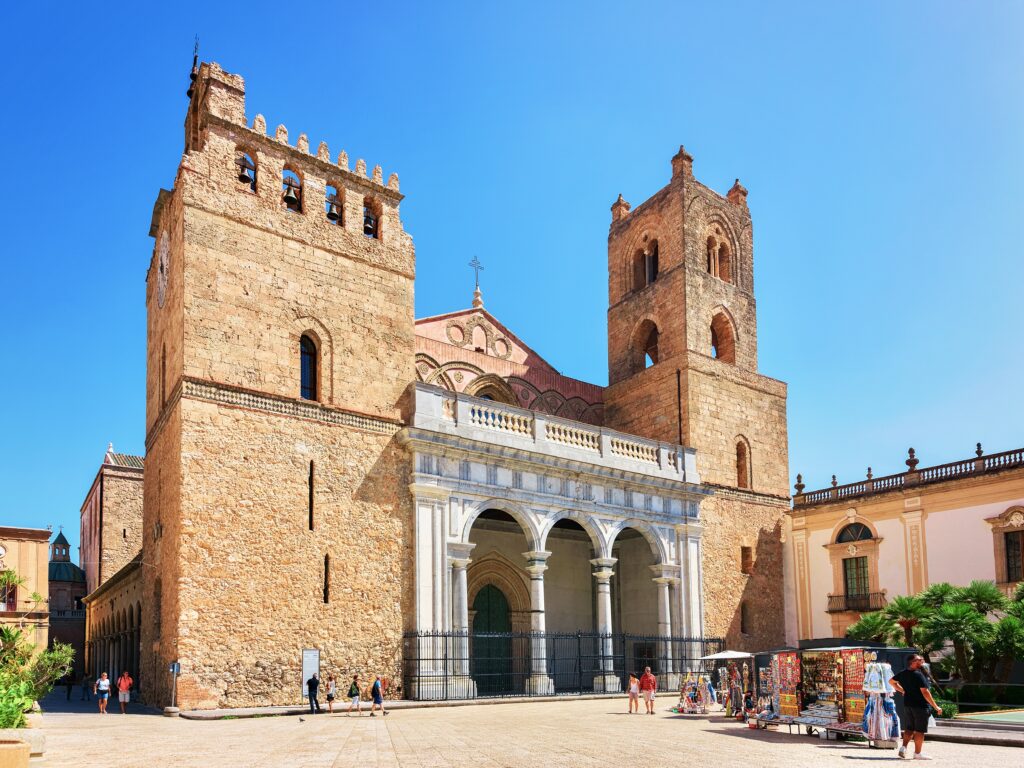
22. Monreale Cathedral, Monreale Sicily
Monreale Cathedral s the world’s most famous Arab-Norman cathedral with an astonishing 68,000 feet of glittering Byzantine mosaics set against 2 tons of gold leaf. It reminded me of St. Mark’s Cathedral.
The cathedral was founded in the 12th century by William II and you’ll see his portrait and tomb. The fortress-like facade has two square corner towers flanking the great marble portal. Be sure to walk around the back where you can see the Moorish decorations.
The bronze doors are called the “Gates of Paradise” and are decorated with 48 panels depicting episodes from the Old and New Testaments. They’re rarely open. But the day I was there they were due to a wedding being held in the cathedral.
The mosaics depict a host of episodes and an endless cast of characters from the story of Genesis. The highlight, in the apse, is a mosaic of Christ Pantocrater. It’s the largest one in Europe. It shows a long haired Christ in glory raising his hand in a two fingered Byzantine-style blessing.
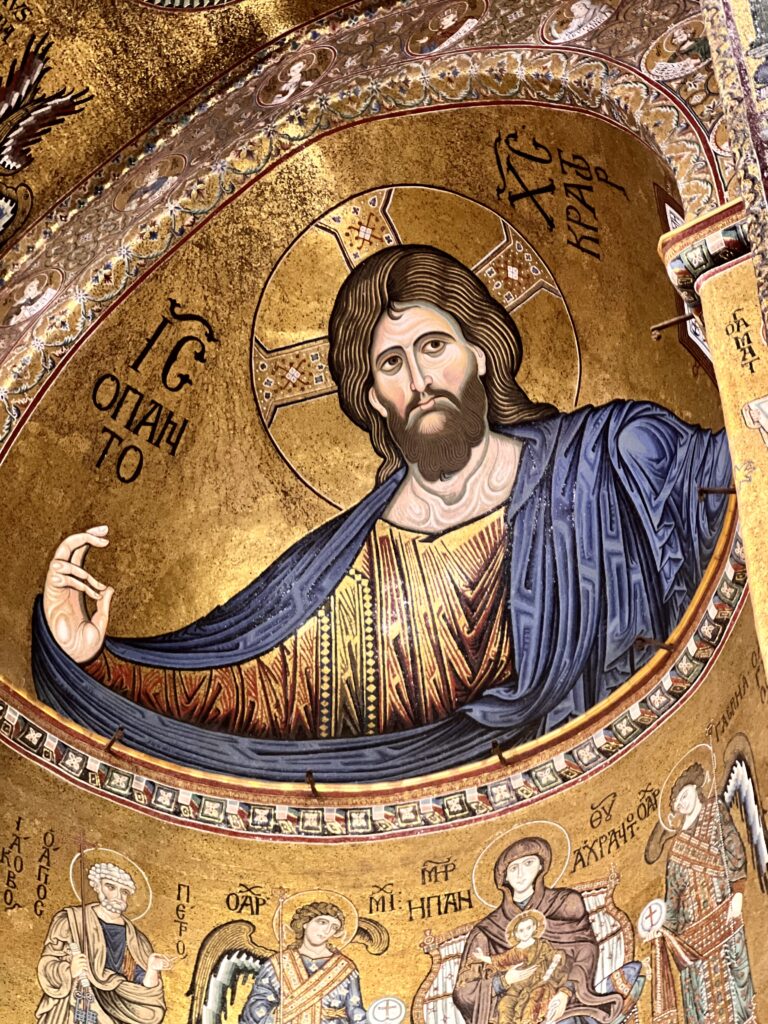
You’ll also be dazzled by the Byzantine-style floors, Corinthian columns, and an intricate carved wood ceiling. The cloisters are also beautiful and the best preserved one of its type in Sicily. They come complete with a fountain that looks straight out of Granada’s Alhambra.
There are 228 Moorish columns made of Carrera marble and inlaid with mosaics. The storytelling capitals depict famous scenes, including a Norman jousting event, William II wearing a Byzantine crown, and a lovemaking scene.
You can also hike up to the top of the church. There’s a circular terrace offering great views of the abbey, the town, and the surrounding area.
Here’s my guide to Monreale Cathedral. To get the full scoop on Monreale Cathedral, you can book a guided tour from an expert.
The traffic in Monreale seemed even worse than Palermo to me. Unless you have nerves of steel, the best way to visit the cathedral is via a half day guided tour from Palermo or, even better, a private tour that incudes the Capuchin Catacombs.
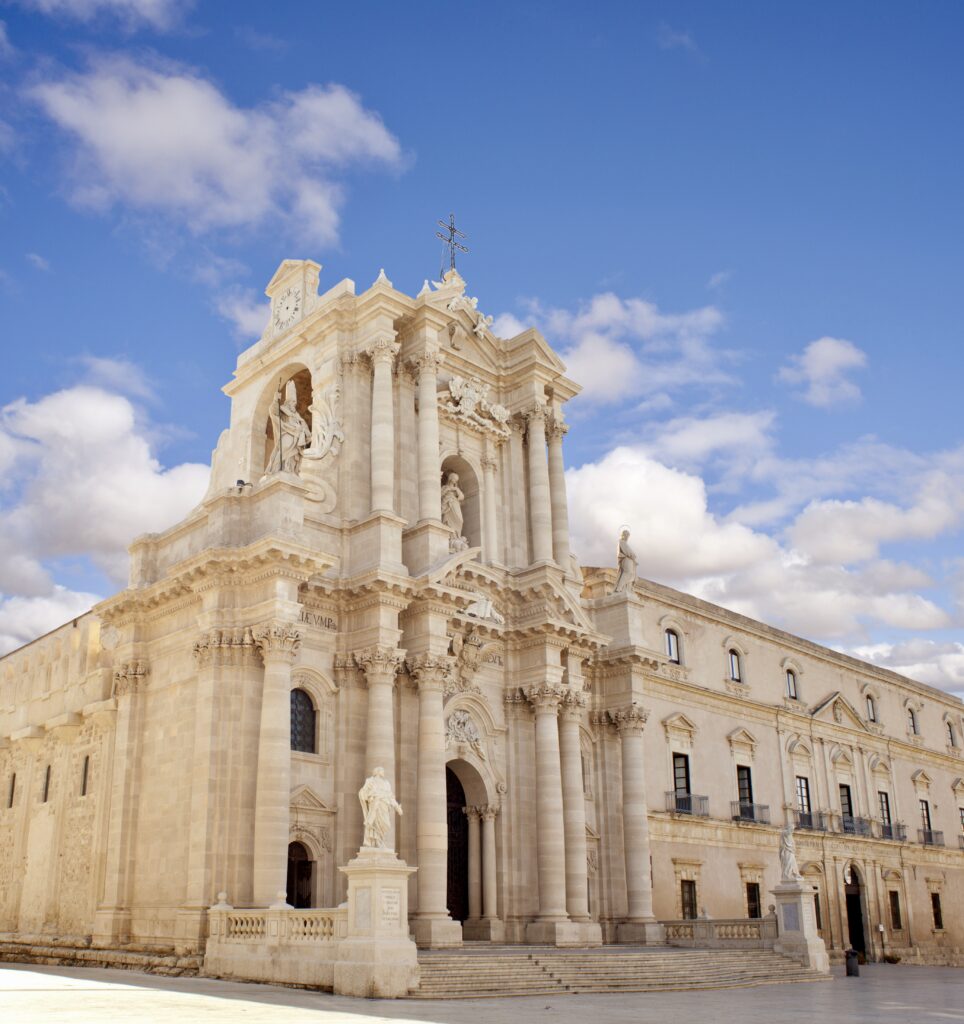
23. Syracuse Cathedral, Siracusa Sicily
Syracuse’s Duomo is one of the most beautiful churches in Italy. It’s remarkable, a fine example of the potpourri melting pot nature of Sicily itself.
You can see Greek, Byzantine, Arab, Norman, and Baroque influences. At the top is the Virgin Mary flanked by Saints Peter and Paul.
The original Norman facade was felled in an earthquake and replaced with a finely chiseled Sicilian Baroque extravaganza. At the top is the Virgin Mary flanked by Saint Peter and Paul. To the right of Mary is Sicily’s patron saint, Santa Lucia.
But the most astonishing part of the church is revealed on its side. Once there was a grand Greek temple, dating from 48 B.C., where the Duomo now stands.
It had 6 columns on the front and back and 14 columns on the side. You can actually see the ancient columns on the exterior and interior of the church.
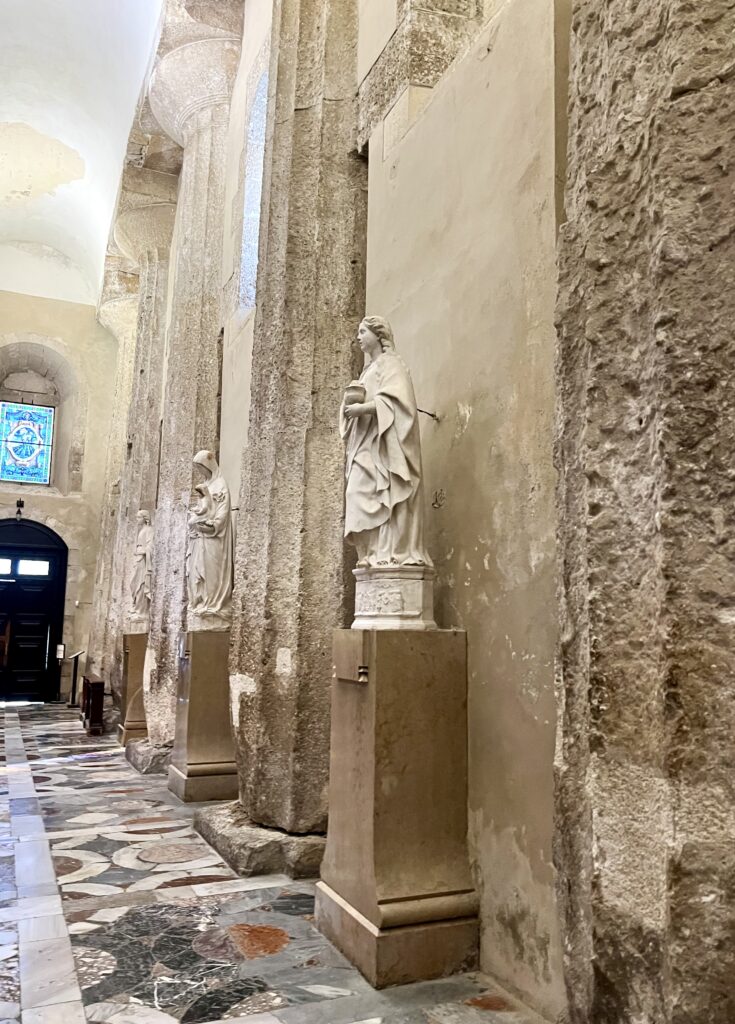
In 535, the Byzantine converted the temple into a church. To create walls, they left the columns and filled them in the space between them.
It’s worth going inside to get the full effect. Pick up an audio guide. Important chapels and the like are labelled by number.
The Duomo has a sever simplicity, with a central nave and two aisles. The nave is separated by a series of arches on each side, added by the Byzantines.
You’ll see the Chapel of Saint Lucia, which contains relics including a bone from her left arm. You can also admire the gorgeous marble floors installed by the Spaniards in the 15th century.
You can visit the cathedral on a guided walking tour of Syracuse.
READ: 2 Days In Syracuse Itinerary
I hope you’ve enjoyed my guide to the most beautiful churches in Italy. You might enjoy these other Italy articles and resources:
- 10 day itinerary for Tuscany
- 10 day itinerary for Italy’s classic cites
- 7 ways to spend 1 week in Italy
- 10 day itinerary from Milan to Rome
- 1 week itinerary from Venice to Milan
- 30 beautiful towns in Italy
- 100+ Italy bucket list experiences
- Tips for visiting Italy
- Historic landmarks in Italy
If you’d like to visit the most beautiful and important churches in Italy, pin it for later.

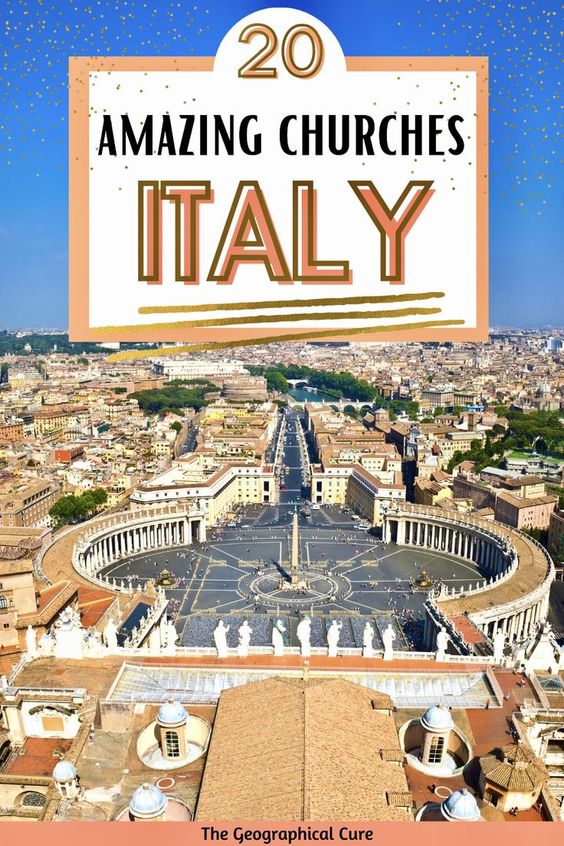
San Vitale is in Ravenna not Padua
Thanks. Dumb typo.
Great list!
I also enjoyed visiting Duomo di Monza and Certosa di Pavia, both stunning.
Excellent, now I have a couple new things to put on my Italy bucket list!